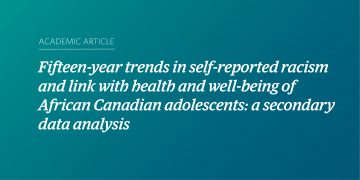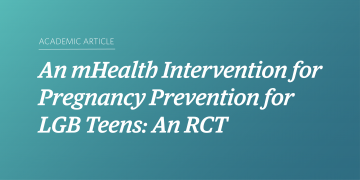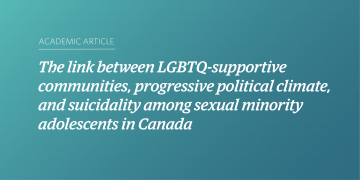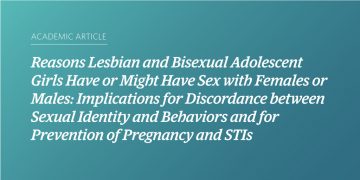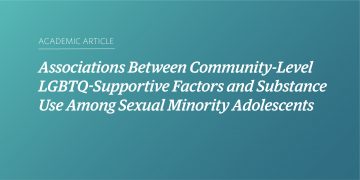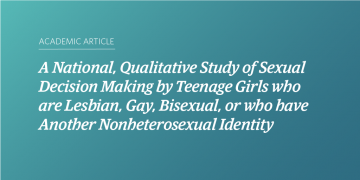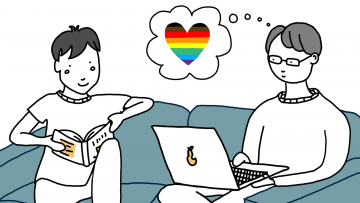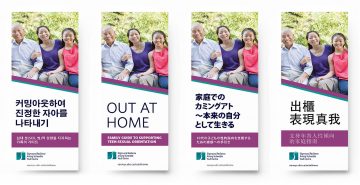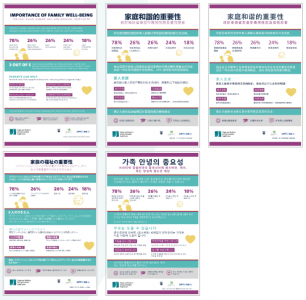Fifteen-year trends in self-reported racism and link with health and well-being of African Canadian adolescents: a secondary data analysis
We assessed the prevalence and trends in racial discrimination among African Canadian adolescents in British Columbia. The association between racial discrimination and self-rated health, access to mental health services, substance use, suicidal thoughts and attempts, experience of extreme stress, among others were examined within the 2018 dataset.
An mHealth Intervention for Pregnancy Prevention for LGB Teens: An RCT
Although lesbian, gay, bisexual and other sexual minority (LGB+) girls are more likely than heterosexual girls to be pregnant during adolescence, relevant pregnancy prevention programming is lacking. Girl2Girl appears to be associated with increases in pregnancy preventive behaviors for LGB+ girls, at least in the short-term. Comprehensive text messaging–based interventions could be used more widely to promote adolescent sexual health behaviors across the United States.
The link between LGBTQ-supportive communities, progressive political climate, and suicidality among sexual minority adolescents in Canada
Despite supportive structural changes to reduce stigma towards lesbian, gay, and bisexual, transgender, queer, and questioning (LGBTQ) Canadian residents, sexual minority youth still face disparities compared to heterosexual peers. We aimed to characterize LGBTQ-supportive environments and political climates, and examine their links to suicidal behavior among sexual minority adolescents in western Canada.
Reasons Lesbian and Bisexual Adolescent Girls Have or Might Have Sex with Females or Males: Implications for Discordance between Sexual Identity and Behaviors and for Prevention of Pregnancy and STIs
We examined reasons lesbian and bisexual adolescent girls have sex or, if sexually inexperienced, might have sex with girls or boys, and the role of internalized homonegativity in these relations and among lesbians.
Associations Between Community-Level LGBTQ-Supportive Factors and Substance Use Among Sexual Minority Adolescents
The availability of LGBTQ community-level organizations, events, and programs may serve as protective factors for substance use among sexual minority adolescents. In particular, LGBTQ-supportive community factors were negatively associated with substance use, which has important implications for our investment in community programs, laws, and organizations that advance the visibility and rights of LGBTQ people.
A National, Qualitative Study of Sexual Decision Making by Teenage Girls who are Lesbian, Gay, Bisexual, or who have Another Nonheterosexual Identity
To address the significant dearth of literature that examines how girls who are lesbian, gay, bisexual, or who have another nonheterosexual identity (LGB+) decide when and with whom to have sex; and to explore why inexperienced LGB+ girls might have sex with girls or boys.
Video resources for East Asian parents recorded in five languages
We’re excited to announce that we’ve just launched a series of video resources for East Asian parents. It’s a family guide for supporting teen sexual orientation filmed in five languages: Cantonese, Mandarin, Korean, Japanese, and English.
Out at Home: Video Resource
A video resource to support East Asian lesbian, gay, and bisexual youth and their families. Available in Cantonese, Mandarin, Korean, Japanese, and English. The series features three videos, each with a specific action that parents can take to support their teen’s sexual orientation.
Out at Home: Brochure Resource
A brochure to support East Asian lesbian, gay, and bisexual youth and their families. Available in English, Traditional and Simplified Chinese, Korean, and Japanese.
Importance of Family Well-being for Lesbian, Gay, and Bisexual East Asian Youth
The following infographic shows key findings from the research into health outcomes among LGB East Asian youth and the role family can play in supporting their well-being. The download is available in English, Traditional Chinese, Simplified Chinese, Japanese, and Korean.
